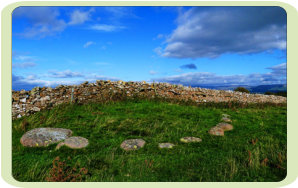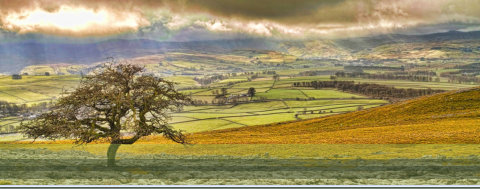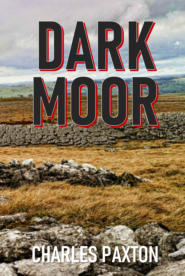

Westmorland Fells
Cumbria Rocks!
My thanks to Tim Woodstrover for his recent help with fixing
up this website! Sept. 2022
Wednesday 12th December 2019
An exploratory tour of prehistoric ring stones, stone rings, henges, mounds and mighty megaliths around the British Lake District. Part 1. by Charles Paxton You’re walking up an ancient Green Lane toward Harberwain in the Westmorland Fells, briskly uphill over springy turf you climb, with the Lake District’s Haweswater Fells at your back and fresh air in your lungs. Surprised sheep pause their grazing to survey you, the surprise is mutual for suddenly you realise yourself standing beside a ring of low stones of Shap granite, pink, with large irregular granular crystals, very hard and very sacred to the Brythonic ancestors who erected them over three thousand years ago. They remain mysterious in their landscape, spared by stock farming from destruction by that curse of archaeology, but blessing to Mankind’s larder, the plough. This is Iron Hill North, a cairn circle bisected by a drystone wall. Tolkein fans may be stirred by the name, view this fine map of Westmoria by Jean Blaeu c1646 to be stirred further! Nearby, lies Iron Hill South, what’s thought to be stoney remnants of a rare skyline barrow, oriented to cardinal points by early Bronze age hands, it too, overlooks the famous Belinus Ley line that passes by Shap village with its archaic Serpentine avenue and nourishing tea shop, warm pubs and fish and chips. I’ve never walked this green lane, nor the moors at night, so whether the way is haunted by Wights or not, I cannot truthfully tell. Apparently the name ‘Shap’ means ‘heap of stones’, bear this in mind as you read on, because I think it represents some ancient British understatement. Now many of those stones are sadly scattered, Carl lofts circle near the site of The Greyhound pub is, but the western half of Kemp Howe Stone circle is very accessible and includes a Shap granite ring stone, the other half is not lost thankfully, but under the railway, and many folk ride over it unknowingly. However many stones from the Shap Serpentine avenue have gone we may not know, but the 12 ton Goggleby stone and nearby double ring-marked stone of Aspers field still point the way to Skellaw Hill, the Hill of skulls, reminding us of one antiquary’s description of ‘vast pyramides’ of stones leading 7 miles in the direction of Knipe Scar and Askham Common! Discover more remains yet among the many limestone walls, testament to the work of Shap Abbey’s Premonstratensian Canons. That’s a mouthful, I’m glad I don’t have to read this out loud. Alongside the southbound M6 lies mighty Gunnerkeld concentric circle, the name means Hunters’ Spring, many early sites are associated with springs, rivers and lakes. To the south, lie Crosby Ravensworth’s, Oddendale concentric circle and across Crosby Moor, The White Hag cairn circle and Penhurrock funerary cairn and above them on Knott Hill, a prehistoric fortress overlooking the 44m broad Gamelands Circle in Orton Valley, all on the popular Coast to Coast walk. This swathe of monuments leads north through Lowther Valley to the high plateau of Moor Divock, described as a ‘complex’ of sites with its Copt stone megalith, ancient chariot way, sepulchral cairn circles, exposed burial cist at White Raise and Cockpit double concentric circle. The grouse cocks still display in the marshy moor, with haunting bubbling cries and fierce red eye-brows. Travel beyond to Mayburgh, at Eamont Bridge near Penrith, where a Class I Henge 150 m across stands ringed with trees. Here 20,000 tons of river stones were piled to form a great ring-mound, putatively described by some as a rare Ring Henge , despoiled by Lord Brougham, one remaining megalith now stands, aligned with the mighty Lakeland Fell Blencathra westwards and the entrance gap faces east to the Class II Henge nearby, King Arthur’s Round Table, once a spring lay between them. The smaller Henge had an entrance at both ends and the ‘table’ was added later as a platform for afternoon tea by the nearby pub, to its south there was a smaller Henge, suggesting a processional arrangement. Somewhere very nearby the bridge is the site of a lost Yamontside Circle. If you find it, please let us know? Southeast of Mayburgh’s gateway, across the Eden Valley the wild sheepscapes of the Pennine mountains stand behind Appleby Golf Club, where visitors can play an 18 hole round of golf for £25 in sight of Fell ponies and The Druidical Judgement seat, a platform overlooking a stream. Beside the 5 th tee are a line of stones, one ringed, running parallel to some gloriously weathered sandstone caves; welcome shelter to hunter gatherers? Northeast of Penrith stands 3 m tall Long Meg, a red sandstone, wrought with weathered spirals and line rock art and her daughters of grey rhyolite, England’s third largest stone circle and one of the oldest and most impactful. Long Meg has cardinal alignment, at the foot of this famous sarsen can be found fresh pagan offerings of flowers, feathers and letters. These megaliths impressed themselves upon local folklore which maintains that the tall graven red sandstone ‘Long Meg’, once a witch, was transformed with her daughters into the stones by a wizard for dancing on a Sunday. It is also said that most visitors cannot count the stones twice and arrive at the same total, but if you get the same count twice watch out, because storm clouds will gather and soak you. That could happen. Perhaps William Wordsworth described the deeply personal discovery experience best, when he found himself unexpectedly among the megaliths of this embanked stone circle near Little Salkeld: “A weight of awe not easy to be borne Fell suddenly upon my spirit - cast, From the dread bosom of the unknown past, when first I saw that sisterhood forlorn; -” He wrote ‘I have not seen any other relique of those dark ages which can pretend to rival it in singularity and dignity of appearance.’ The sense of discovery is as accessible to us as the Romantic poets of the past and there seems much yet to discover. Cumbria has over two hundred known prehistoric sites, most of the best are freely accessible to visitors, this amounts to a significant proportion of Europe’s prehistoric heritage. There are likely to be more, as yet undiscovered. What are they all and why are they here? Let’s explore!


Bring a friend
Made with Xara
© This site and its contents are copyright 2010-22 by C.Paxton and other contributing members of the Westmorland Fells Group.


Blog

Celebrating Cumbria’s Carboniferous Fells and Dales

Cumbria Rocks!
My thanks to Tim Woodstrover for
his recent help with fixing up this
website! Sept. 2022
Wednesday 12th December 2019
An exploratory tour of prehistoric ring stones, stone rings, henges, mounds and mighty megaliths around the British Lake District. Part 1. by Charles Paxton You’re walking up an ancient Green Lane toward Harberwain in the Westmorland Fells, briskly uphill over springy turf you climb, with the Lake District’s Haweswater Fells at your back and fresh air in your lungs. Surprised sheep pause their grazing to survey you, the surprise is mutual for suddenly you realise yourself standing beside a ring of low stones of Shap granite, pink, with large irregular granular crystals, very hard and very sacred to the Brythonic ancestors who erected them over three thousand years ago. They remain mysterious in their landscape, spared by stock farming from destruction by that curse of archaeology, but blessing to Mankind’s larder, the plough. This is Iron Hill North, a cairn circle bisected by a drystone wall. Tolkein fans may be stirred by the name, view this fine map of Westmoria by Jean Blaeu c1646 to be stirred further! Nearby, lies Iron Hill South, what’s thought to be stoney remnants of a rare skyline barrow, oriented to cardinal points by early Bronze age hands, it too, overlooks the famous Belinus Ley line that passes by Shap village with its archaic Serpentine avenue and nourishing tea shop, warm pubs and fish and chips. I’ve never walked this green lane, nor the moors at night, so whether the way is haunted by Wights or not, I cannot truthfully tell. Apparently the name ‘Shap’ means ‘heap of stones’, bear this in mind as you read on, because I think it represents some ancient British understatement. Now many of those stones are sadly scattered, Carl lofts circle near the site of The Greyhound pub is, but the western half of Kemp Howe Stone circle is very accessible and includes a Shap granite ring stone, the other half is not lost thankfully, but under the railway, and many folk ride over it unknowingly. However many stones from the Shap Serpentine avenue have gone we may not know, but the 12 ton Goggleby stone and nearby double ring-marked stone of Aspers field still point the way to Skellaw Hill, the Hill of skulls, reminding us of one antiquary’s description of ‘vast pyramides’ of stones leading 7 miles in the direction of Knipe Scar and Askham Common! Discover more remains yet among the many limestone walls, testament to the work of Shap Abbey’s Premonstratensian Canons. That’s a mouthful, I’m glad I don’t have to read this out loud. Alongside the southbound M6 lies mighty Gunnerkeld concentric circle, the name means Hunters’ Spring, many early sites are associated with springs, rivers and lakes. To the south, lie Crosby Ravensworth’s, Oddendale concentric circle and across Crosby Moor, The White Hag cairn circle and Penhurrock funerary cairn and above them on Knott Hill, a prehistoric fortress overlooking the 44m broad Gamelands Circle in Orton Valley, all on the popular Coast to Coast walk. This swathe of monuments leads north through Lowther Valley to the high plateau of Moor Divock, described as a ‘complex’ of sites with its Copt stone megalith, ancient chariot way, sepulchral cairn circles, exposed burial cist at White Raise and Cockpit double concentric circle. The grouse cocks still display in the marshy moor, with haunting bubbling cries and fierce red eye-brows. Travel beyond to Mayburgh, at Eamont Bridge near Penrith, where a Class I Henge 150 m across stands ringed with trees. Here 20,000 tons of river stones were piled to form a great ring-mound, putatively described by some as a rare Ring Henge , despoiled by Lord Brougham, one remaining megalith now stands, aligned with the mighty Lakeland Fell Blencathra westwards and the entrance gap faces east to the Class II Henge nearby, King Arthur’s Round Table, once a spring lay between them. The smaller Henge had an entrance at both ends and the ‘table’ was added later as a platform for afternoon tea by the nearby pub, to its south there was a smaller Henge, suggesting a processional arrangement. Somewhere very nearby the bridge is the site of a lost Yamontside Circle. If you find it, please let us know? Southeast of Mayburgh’s gateway, across the Eden Valley the wild sheepscapes of the Pennine mountains stand behind Appleby Golf Club, where visitors can play an 18 hole round of golf for £25 in sight of Fell ponies and The Druidical Judgement seat, a platform overlooking a stream. Beside the 5 th tee are a line of stones, one ringed, running parallel to some gloriously weathered sandstone caves; welcome shelter to hunter gatherers? Northeast of Penrith stands 3 m tall Long Meg, a red sandstone, wrought with weathered spirals and line rock art and her daughters of grey rhyolite, England’s third largest stone circle and one of the oldest and most impactful. Long Meg has cardinal alignment, at the foot of this famous sarsen can be found fresh pagan offerings of flowers, feathers and letters. These megaliths impressed themselves upon local folklore which maintains that the tall graven red sandstone ‘Long Meg’, once a witch, was transformed with her daughters into the stones by a wizard for dancing on a Sunday. It is also said that most visitors cannot count the stones twice and arrive at the same total, but if you get the same count twice watch out, because storm clouds will gather and soak you. That could happen. Perhaps William Wordsworth described the deeply personal discovery experience best, when he found himself unexpectedly among the megaliths of this embanked stone circle near Little Salkeld: “A weight of awe not easy to be borne Fell suddenly upon my spirit - cast, From the dread bosom of the unknown past, when first I saw that sisterhood forlorn; -” He wrote ‘I have not seen any other relique of those dark ages which can pretend to rival it in singularity and dignity of appearance.’ The sense of discovery is as accessible to us as the Romantic poets of the past and there seems much yet to discover. Cumbria has over two hundred known prehistoric sites, most of the best are freely accessible to visitors, this amounts to a significant proportion of Europe’s prehistoric heritage. There are likely to be more, as yet undiscovered. What are they all and why are they here? Let’s explore!

Advertisement

Charles Paxton’s new historical
fantasy novel “Dark Moor” is now
available on Amazon Kindle! The
book is set in the Westmorland Fells
and some other noteworthy sites in
Cumbria.
Please click the above link or the
cover image to view the title in a new
window.
© This site and its contents are copyright 2010-22 by C.Paxton and
other contributing members of the Westmorland Fells Group.




















